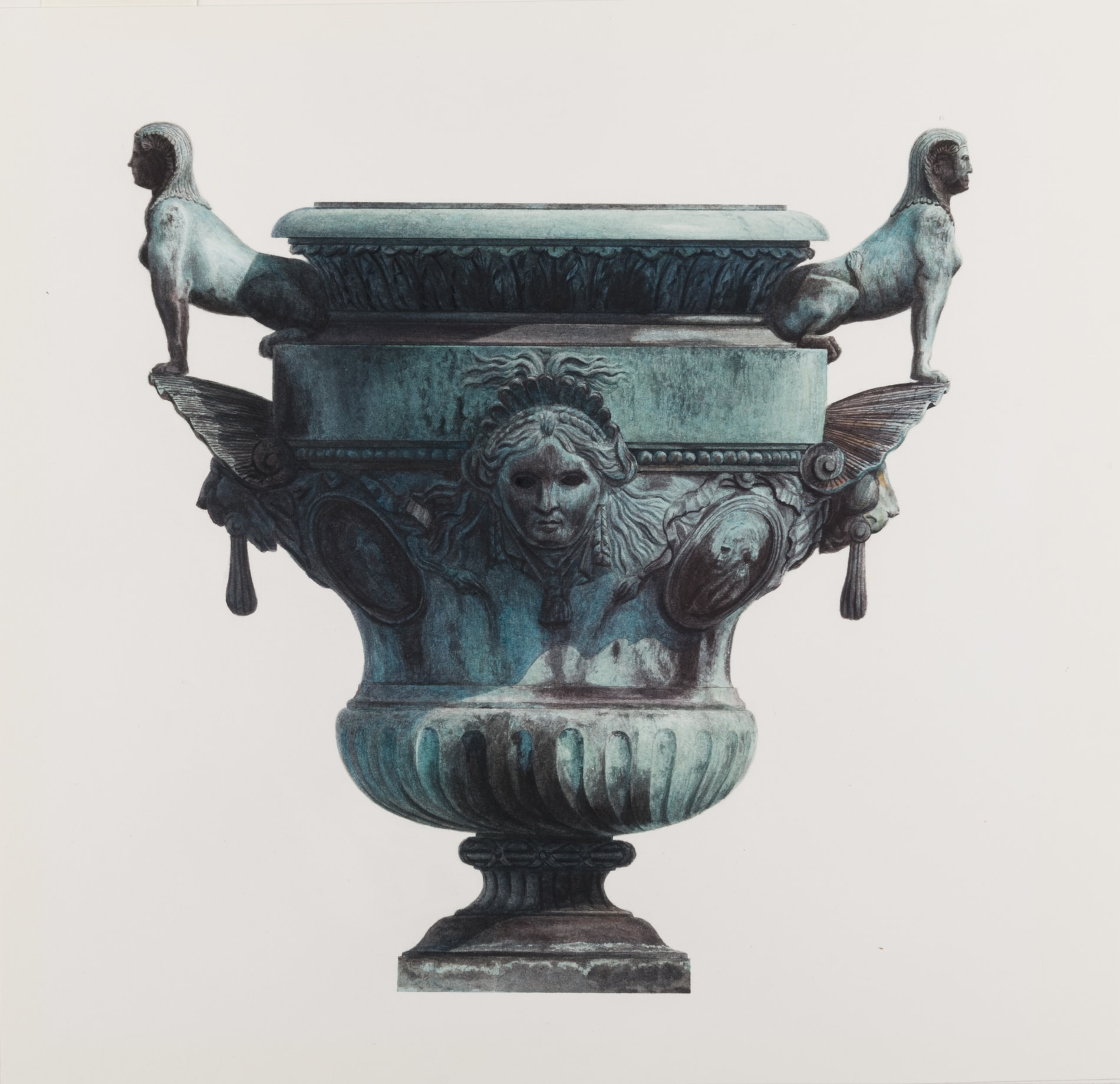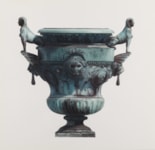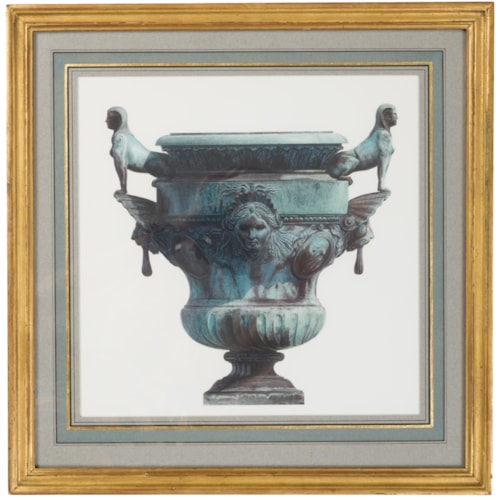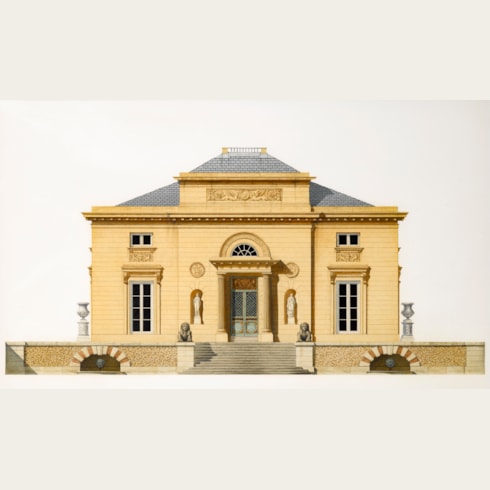DAMS & ZEGA
A Bronze Garden Vase with Sphinxes, for the Parterre du Midi at Versailles
Watercolour.
Signed, titled and dated Bronze Vase at Versailles / © 1995 Edward Andrew Zega / & Bernd H. Dams / - All rights reserved - on the verso.
333 x 346 mm. (13 1/8 x 13 5/8 in.)
Signed, titled and dated Bronze Vase at Versailles / © 1995 Edward Andrew Zega / & Bernd H. Dams / - All rights reserved - on the verso.
333 x 346 mm. (13 1/8 x 13 5/8 in.)
Thought to be after a design by the 17th century French sculptor and silversmith Claude Ballin the Elder (1615-1678), this large garden vase in the form of an urn was executed for the gardens of Versailles around 1665. Five of these ‘Ballin’ designs for vases were reproduced in etchings by Jean Le Pautre in the early 1670s, and through such prints, these garden vases became popular throughout Europe and were reproduced in numerous 17th and 18th century copies.
As the curator Gérard Mabille has written, ‘Great urns and vases in marble, bronze or lead are among the most handsome ornaments of classical gardens. They are to be found in particular abundance at Versailles, where they line parterres and bosquets or punctuate avenues and perspectives with their monumental silhouettes. Lofty landmarks or guardian spirits, they seem to invite those strolling through the gardens to pause a moment to contemplate the scenes from classical mythology…that unfurl seamlessly on the flawless curves of their flanks.’
The same writer has further noted that, ‘While marble was the medium par excellence of the most monumental urns and vases at Versailles, metal was also a favoured material; more than any others, vases in precious metal were the most appropriate symbol of a return to a Golden Age…in the gardens at the foot of the palace walls…[are] the celebrated set of twenty-six bronze vases attributed to Ballin…What do these masterpieces owe to the great goldsmith Ballin? No one knows for certain, though some speculate that he produced the designs. What we do know is that the models were supplied from 1665 by the sculptors Anguier, Magnier, Legendre and Tubi, and that the finished pieces were cast by Duval, Prévost, and Picard. Arranged in pairs on the marble sills overlooking the Parterre du Nord and the Parterre du Midi, the ‘Ballin’ vases display imagination and poetry in equal measure in their interpretation of classical Greek and Roman sources. Decorated with antique medallions, gadroons, ova and frets, and garlands of laurel and oak, acanthus and ivy, they are enlivened by a throng of playful or pouting cupids, chimeras, sphinxes, dragons and satyrs…Of remarkably skilful workmanship, they were doubtless intended to be gilded, though this work was never carried out. Like their silver counterparts, they are imbued with a lyricism that is at once subtle, harmonious and consummately Virgilian in spirit.’
As the curator Gérard Mabille has written, ‘Great urns and vases in marble, bronze or lead are among the most handsome ornaments of classical gardens. They are to be found in particular abundance at Versailles, where they line parterres and bosquets or punctuate avenues and perspectives with their monumental silhouettes. Lofty landmarks or guardian spirits, they seem to invite those strolling through the gardens to pause a moment to contemplate the scenes from classical mythology…that unfurl seamlessly on the flawless curves of their flanks.’
The same writer has further noted that, ‘While marble was the medium par excellence of the most monumental urns and vases at Versailles, metal was also a favoured material; more than any others, vases in precious metal were the most appropriate symbol of a return to a Golden Age…in the gardens at the foot of the palace walls…[are] the celebrated set of twenty-six bronze vases attributed to Ballin…What do these masterpieces owe to the great goldsmith Ballin? No one knows for certain, though some speculate that he produced the designs. What we do know is that the models were supplied from 1665 by the sculptors Anguier, Magnier, Legendre and Tubi, and that the finished pieces were cast by Duval, Prévost, and Picard. Arranged in pairs on the marble sills overlooking the Parterre du Nord and the Parterre du Midi, the ‘Ballin’ vases display imagination and poetry in equal measure in their interpretation of classical Greek and Roman sources. Decorated with antique medallions, gadroons, ova and frets, and garlands of laurel and oak, acanthus and ivy, they are enlivened by a throng of playful or pouting cupids, chimeras, sphinxes, dragons and satyrs…Of remarkably skilful workmanship, they were doubtless intended to be gilded, though this work was never carried out. Like their silver counterparts, they are imbued with a lyricism that is at once subtle, harmonious and consummately Virgilian in spirit.’
The architectural historians and illustrators Bernd Dams and Andrew Zega have collaborated on a series of remarkable watercolours depicting significant examples of architecture, garden architecture and ornament in France in the century and a half before the Revolution. As the late Charles Ryskamp has noted of these works, ‘The paintings are brilliant and original. The author/artists, American and German, have captured the French genius of these buildings through the medium of watercolor, which enables the rendition of various building materials and surfaces with remarkable versatility and sensitivity. The illustrations overcome the special problems of recreating the appearance of each building. The paintings are abstractions of the elevations of the main facades of each building; yet they are also informative of the architectural peculiarities of the entire structure. The resulting illustrations both document the architectural past and are modern works of art in their own right.’
A German architect and architectural historian whose doctoral thesis was on the Château of Marly, Dams met Zega, an American artist and writer, in the early 1990s, when both were employed at the architectural firm of Robert A. M. Stern in New York. The two began collaborating on detailed and historically accurate watercolours of buildings and ornament, with an emphasis on French architecture of the 17th and 18th centuries, notably the Palace of Versailles. Many of the buildings depicted no longer exist, and their splendid watercolours are thus based on contemporary accounts, descriptions and illustrations. Dams and Zega have written and illustrated four books: Pleasure Pavilions and Follies, published in 1995, Garden Vases (2000), Palaces of the Sun King: Versailles, Trianon, Marly (2002) and Chinoiseries (2006). Watercolours by Dams and Zega are today in the collections of The New-York Historical Society and the Cooper-Hewitt, National Design Museum in New York, the Princeton University Art Museum, and the Musée de l’Ile de France at the Château de Sceaux. Works by the artists are also in numerous private collections, including those of Brooke Astor, Robert Denning, Hubert de Givenchy, Oscar de la Renta and Jayne Wrightsman.
A German architect and architectural historian whose doctoral thesis was on the Château of Marly, Dams met Zega, an American artist and writer, in the early 1990s, when both were employed at the architectural firm of Robert A. M. Stern in New York. The two began collaborating on detailed and historically accurate watercolours of buildings and ornament, with an emphasis on French architecture of the 17th and 18th centuries, notably the Palace of Versailles. Many of the buildings depicted no longer exist, and their splendid watercolours are thus based on contemporary accounts, descriptions and illustrations. Dams and Zega have written and illustrated four books: Pleasure Pavilions and Follies, published in 1995, Garden Vases (2000), Palaces of the Sun King: Versailles, Trianon, Marly (2002) and Chinoiseries (2006). Watercolours by Dams and Zega are today in the collections of The New-York Historical Society and the Cooper-Hewitt, National Design Museum in New York, the Princeton University Art Museum, and the Musée de l’Ile de France at the Château de Sceaux. Works by the artists are also in numerous private collections, including those of Brooke Astor, Robert Denning, Hubert de Givenchy, Oscar de la Renta and Jayne Wrightsman.
Provenance
Didier Aaron, Inc. New York
Pierre Durand, New York.
Pierre Durand, New York.
Literature
Andrew Zega and Bernd H. Dams, Garden Vases, Paris, 2000, pp.16-17.






